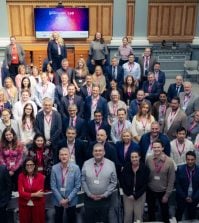Can better use of data help governments be more resilient?

Experts at a recent webinar explored how countries have been affected differently by the pandemic. But there was one thing that could help them prepare better for future crises– accessibility to, and better use of, data.
COVID-19 has had a profound impact on nearly every country on the planet, with governments spending previously unthought of sums both fighting the virus and providing stimuluses to revive beleaguered economies. However, countries did not start from the same base so the pandemic’s impact is varied across each, as demonstrated by research by Swiss Re.
Last year, Swiss Re launched its Resilience Index, which ranks countries’ economic resilience according to a wide range of macroeconomic indicators. It has been updated to take account of the pandemic and the results were shared with an international audience during a webinar sponsored by Swiss Re and hosted by Global Government Forum in November this year.

The event opened with a presentation from Jerome Jean Haegeli, group chief economist at Swiss Re, who provided a helicopter view of the index and introduced delegates to another Swiss Re initiative, its Pandemic Macro Clock. This plots the state of play in different countries including the penetration of the virus and the extent to which economies are open or shut. The key to both, Haegeli said, is the availability of solid data.
“We are definitely still in a very difficult economic environment,” he said. “Europe is facing a double-dip recession. Economic resilience globally was lower than before the global financial crisis (GFC) and obviously COVID-19 dragged it even further below. Now, I think it’s really important to build up the resilience and this can only be done if countries improve the monetary policy space, the fiscal space, but also think about the longer term.”
We need to prepare better for the next big challenge
Haegeli acknowledged that different countries were in different places, but he urged that even where governments had the headroom to do so, they should not copy GFC policy responses. “Now it’s time to build up the post-crisis recovery and not just use the past-crisis recipes, which were cheap money and spending like there is no tomorrow,” he said.
Instead, Haegeli urged governments to start preparing now for the next big challenges. The event took place just a day after Pfizer and BioNTech announced that early data indicated that their vaccine candidate was 90% effective. This demonstrated, Haegeli said, that the pandemic was likely to end at some point: the same could not be said for other risks such as climate change.
Haegeli’s presentation also highlighted how differently countries had performed in terms of maintaining their resilience during the pandemic. While the UK had fallen down the index – from sixth place in 2019 to 14th this year – other countries had maintained their positions, albeit that their resilience rating had inevitably taken a hit. Most prominently, Switzerland, Canada and Finland retained their first, second and third places respectively.
Public trust in Finland
Markus Sovala, director general and economic policy coordinator at the Ministry of Finance in Finland, noted that his country’s infection rate was now the lowest in Europe, something that he felt demonstrated its resilience. The difference, he added, couldn’t simply be explained by factors such as Finland’s low population density.

“An important part of the resilience is actually trust,” said Sovala. “It’s that people trust authorities, people trust each other, people basically assume that other people are acting in good faith and they are at least partly competent and capable of doing what they are aiming to do. This is my personal theory that very much explains why the Finnish situation has been so positive.”
Sovala was open about the fact that Finland wasn’t out of the woods yet. “It’s very reasonable to expect at least some convergence [when it comes to the infection rate],” he said. “People are travelling and the seasonal effect could be much more negative in Finland than in other countries – the influenza period is starting. So, it’s reasonable to assume that the good figures could look less positive in in in a few weeks’ time.”
Furthermore, a vaccine would provide a panacea any time soon, argued Sovala. “Of course, it’s a really extremely good news that we received yesterday,” he said. “But there is also bad news in the sense that we know that there will be no real effect stemming from any vaccination before next summer. So, the overall situation will remain very similar until let’s say next May or June because the number of people who can be vaccinated will be relatively low next spring.”
Micro differences, macro similarities
For his part, Professor Domenico Siniscalco, former director general of the Italian Treasury and Italian minister of economy and finance, and currently managing director and vice chairman of Morgan Stanley Europe, said that it was remarkable how similar the picture had been – and continues to be – in different countries around the world. This, he said, undermined people’s criticisms of their own governments.

“There are countries where the effects have been less important, say Finland, but overall the shape of the curve in the first and in the second wave is somehow the same,” said Siniscalco. “And therefore, when people complain about their own national pattern of pandemic, this is a provincial view. The number of infected people picked up then plateaued, arrived to a ceiling and then dropped down again in a similar way.”
Infection rates increased again in most countries as lockdown restrictions were lifted, but Siniscalco was also encouraged by the strength of the recovery during the summer. “GDP dropped in an unprecedented way,” he said. “In Italy, we had a drop of economic activity of about 10% on a yearly basis and almost 20% on a quarterly basis. But in the third quarter, the rebound was plus 16.7%, so a V-shaped recovery.”
Looking to the future
In terms of longer term recovery, Siniscalco felt Europe was responding well, not least by setting up the EU Recovery Fund, which aims to help governments fundamentally change the nature of their economies. “Structural transformation means investment in areas that define a new and better growth path,” he said. “And that means greening of the economy; digitalising the economy. COVID-19 will be a watershed moment and we need to update our economies.”

When it comes to monitoring the ongoing fight against the pandemic and finding recovery solutions, Veronica Scotti, chairperson of public sector solutions at Swiss Re, announced that the company has set up a Risk Resilience Center. This pro bono initiative works with thousands of partners to pool data and provide answers to questions in a developing situation. Veronica invited participants to reach out and learn more about the Risk Resilience Center.
The Center currently integrates COVID-19 related health, economic and social data in one unique platform to help guide COVID-19 related workplace policies, mental health management or capital requirements.
“I hope everyone would concur that no one has all the answers, but there is value in bringing our heads together and each one trying to contribute to the best of their abilities,” she said. “It is very much a resilience programme, for now, focused around COVID.”
The point, Scotti concluded, isn’t just to provide solutions for the current situation but to protect against future crises.
“The re/insurance industry is stepping up work on greater transparency and access to data. Swiss Re is very interested to hear from governments and local authorities on how better policies could help get the crisis under control. Can a global data platform for managing and building resilience against global crises be part of the answer? I really don’t want to depress anyone, but our view is that this is not the first and the last pandemic that we will go through. But we have a choice to make on how we handle it going forward.”
For further information please contact Swiss Re. You can view the full webinar on-demand and access the presentation slides by completing the form below.

















